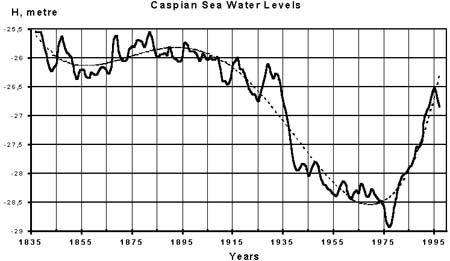Changing sea levels
The reasons why the levels in the Caspian Sea change have been examined in great
detail. Most researchers believe the major influences to be river inflow and sea
evaporation, both of which have altered considerably over the past few decades through
changes in the global climate.

Long-term variation
During the past two centuries, apart from small annual variations, sea levels have
been more than 3.5 m higher (1800) and 2.1 m lower (1977) than its present level. A rapid
decline started from about 1930, probably due to the filling of reservoirs and other water
resource developments. By 1955, conditions seemed to stabilise but then major changes
occurred from 1976 onwards.
Medium-term variation
The annual average evaporation from the Sea was 984mm for the period 1955-75 and
has fallen to 908mm for 1976-96, a reduction of 8%. Inflows into the Sea, however, show a
9.6% increase for the same period. These two factors have led to a significant sea level
rise.
Influence of KBG: [needs more info]
Prognosis
Simulating natural systems is complicated. It is no surprise, therefore, that
different future climate scenarios have been devised, all equally rigorous scientifically,
and that they each produce different predictions. The task for the CCWLF is to assess the
research results on future risks and hazards to the region and evaluate the feasibility
and likely consequences of the alleviation measures proposed.
Storm surges
It is not possible to forecast these in real time at present because of data
limitations. Undoubtedly, zoning and flood warning systems will be the most appropriate
actions to take to reduce flood impacts. Further, a centralised service is being
established,to provide advice to private industry on potential flood hazards. |